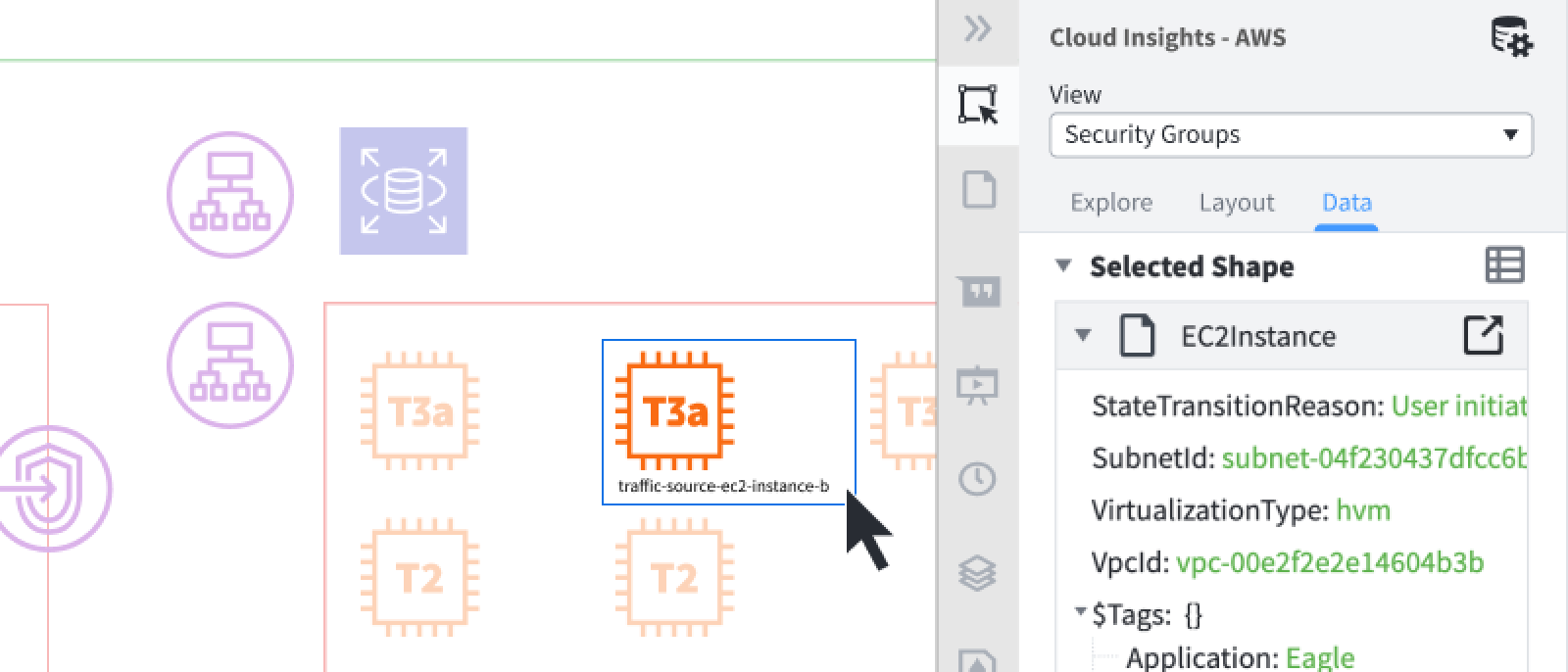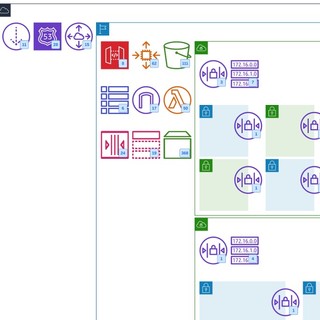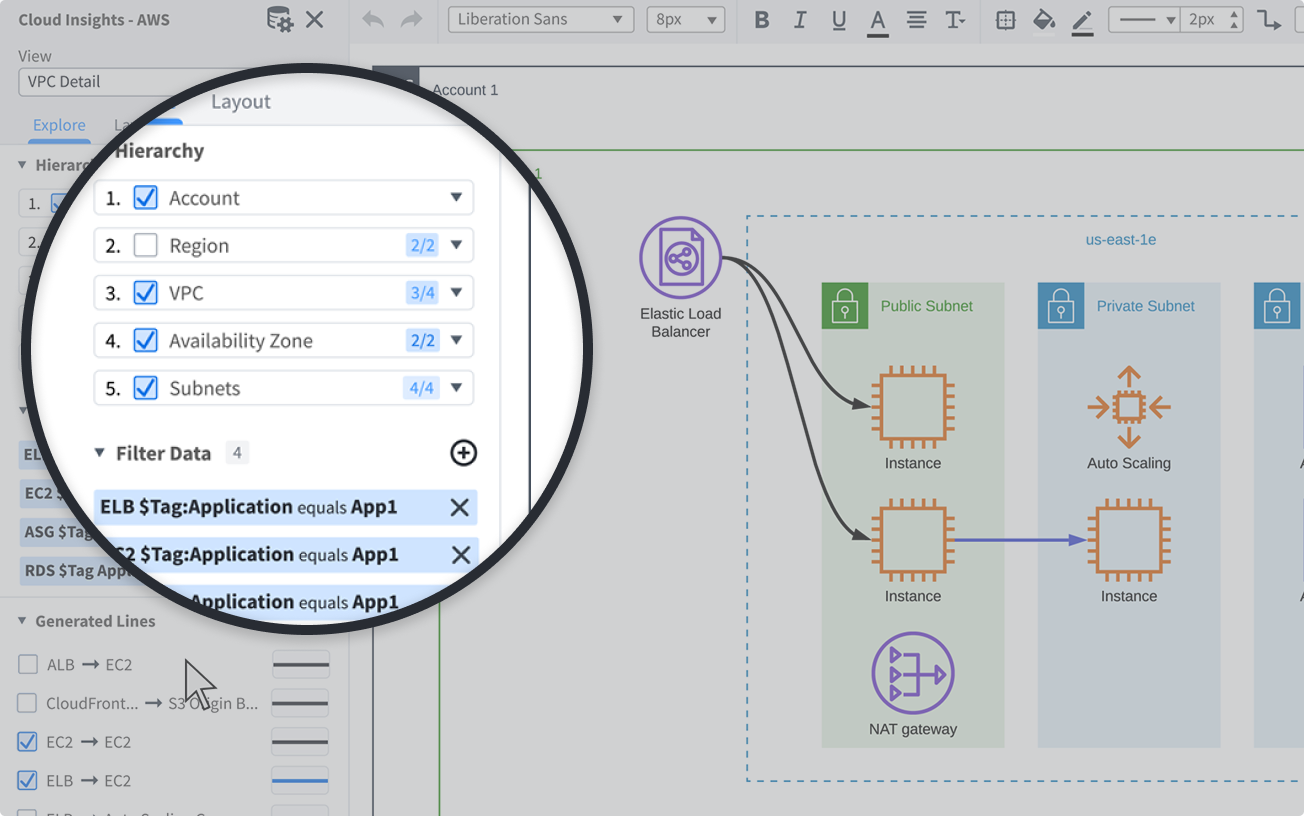
How to use Lucidscale for the 5 pillars of cloud architecture
Jennifer Jackson
Reading time: about 10 min
Topics:
92% of organizations already operate at least somewhat in the cloud, but not every organization does it well. To have a resilient and effective cloud infrastructure, businesses need dedicated budget, buy-in, time, resources, and visibility into their cloud infrastructure.
While operating in the cloud can feel overwhelming at first, the key is to have a well-architected cloud framework and the right platforms to help you plan, implement, and monitor your cloud environments. A strong foundation for your organization’s cloud environment protects you from downtime, ensures that you meet compliance standards, and can save millions of dollars over time.
Most well-architected frameworks follow a variation of the five pillars of cloud architecture, which account for most of your cloud initiatives. And in this post, we’ll help you understand exactly how Lucidscale can help you put these pillars into practice.
The 5 pillars of cloud architecture: CROPS
Incorporating the five pillars of cloud architecture into your cloud processes and internal reviews provides cloud engineers and architects with proven guidelines to design, evaluate, and implement cloud architecture that can scale over time.
CROPS is a mnemonic device that makes it easy to remember the pillars of cloud architecture:
- Cost optimization
- Reliability
- Operational excellence
- Performance efficiency
- Security
Failing to employ CROPS while building your architecture leaves your systems vulnerable and might not meet industry and compliance expectations. With the help of Lucidscale, you can ensure each pillar is getting the attention it needs.
Cost optimization
Any organization using the cloud knows there are many different aspects of cloud computing that can get costly–scaling your infrastructure, downtime, and manpower (just to name a few).
The goal of cost optimization is to manage costs in order to maximize the value delivered for your cloud architecture. It is about having a clear understanding and control of the money spent on the cloud by eliminating unused components and refining sub-optimal processes.
Lucidscale gives organizations a clear picture of their cloud infrastructure and where and how money is being spent. Here’s how you can use Lucidscale to optimize your cloud costs.
1. Only pay for what you’re using
It’s hard to identify from the console what your organization has deployed in the cloud. It’s possible that someone built and deployed pieces of your cloud architecture and then left the company, making it difficult for others to know what is out there.
With Lucidscale, you can automatically generate an architecture diagram simply by connecting to your AWS, Google Cloud, or Azure cloud environment through third-party access.
Having a visual representation of your infrastructure may point out redundancies or realize resources that are no longer needed.
2. Reduce downtime
Gartner reported that network downtime costs an average of $5,600 per minute or $300,000 per hour. That’s a big cost for something that could potentially be avoided. Of course, there are many causes of downtime when it comes to the cloud. For example, deploying new cloud architecture requires participation from many teams. With the changing of so many hands, plans might get unknowingly altered, making it easy for small and even large breakdowns to slip through the cracks that result in downtime.
With Lucidscale, compare your “blueprint” diagram with your current state diagram. That way, it’s easy to spot if the diagrams don’t match, revealing potential downtime risks. With your diagram in hand, you can direct stakeholders to the exact location of misalignment and where the correction needs to be made, ultimately resolving incidents faster.
3. Automate
Building out cloud diagrams manually can take up to several hours and sometimes even days. Manual cloud architecture diagramming is complex and time-consuming, leaving diagrams open to human error. For example, architects can make decisions about future states based on current state diagrams, but if the current state is wrong, then the future state could either create new limitations, cause downtime, or make your organization non-compliant.
Just import data from your third-party cloud provider directly into Lucidscale to automatically generate diagrams of your entire infrastructure organized by cloud, region, and even down to instances and resources.
Now your teams can focus their time optimizing your cloud architecture and executing on deployments that help you gain a competitive edge. While auto-generated diagrams seem simple, these visuals not only save you time and money in the upfront cost of hours spent diagramming, but they also help avoid human error that might result in downtime and technical debt.
Here what customers that use Lucidscale say.
“I used to spend anywhere between four to seven hours on a diagram for a customer, whereas now I could just pull it and make some tweaks, maybe change certain views, and send it over in less than 15 minutes,” said Aravind Marthineni a solutions architect associate at Observian.

Take a page from Observian and find out how they use Lucidscale to gain visibility into their existing architecture to get aligned with their customers.
Read moreReliability
Reliability ensures that your cloud systems can meet their operational threshold, workload demands, and can quickly recover from failures and downtime.
The key to setting up a reliable cloud environment is establishing KPIs that monitor and alert you when something in your architecture fails, immediately triggering the appropriate recovery response. It’s also important to monitor your system utilization, allocating resources based on demand so that your systems continue running at an optimal level. Well-maintained, up-to-date diagrams ensure teams are communicating accurate information to get systems back up and running if a failure were to occur.
Lucidscale makes it easy to validate that systems are built the way the architect designed it. Think about it like comparing what is in your head vs. reality. Visualizing your cloud architecture helps teams build well-architected environments by identifying and flagging elements that have been designed in unreliable ways, potentially avoiding outages or problems before they happen. Having a visual representation of the current and future states of your infrastructure gives you the necessary visibility into existing architecture, while also providing an opportunity to understand scenarios that lead to downtime and failures, ultimately informing future state changes and iterations.
Operational excellence
This pillar aims to drive business value through a combination of continuous improvement, system monitoring, and processes.
One of the key principles of operational excellence is to plan your architecture accordingly and build in space for your network to grow and make adjustments as your organization’s vision and goals change.
To maintain operational excellence, stay agile and make small, continuous improvements to your infrastructure. With Lucidchart Cloud Insights, you can convert your data-backed "live" diagram into an editable version that allows you to manually make changes to the diagram, helping you plan and visualize future deployments. With both the current and future state of your cloud infrastructure, share the diagrams via Slack, @mention other users, or use Presentation Mode in meetings to get input from others on the proposed changes.
Traditional architecture diagrams are difficult to digest. That's why it's important to have a few different versions of your diagram customized to specific scenarios , such as:
-
Planning architecture designs: Communicate with engineers, architects, and coders to ensure that all pieces of information are accurate to avoid mistakes during implementation so you can avoid costly downtime.
-
Presenting to non-technical stakeholders and leadership: Show specific parts of your diagram in Presentation Mode as a simple overview of the architecture or network to any stakeholder, so you can get the buy-in you need.
-
Drill into the right information: Customize what you see in Lucidscale through filters, lines, and additional layout changes. Check out some of our standard views to see an overview of accounts, regions, VPCs, VPC peering connections, and more, or create your own custom views to troubleshoot specific parts of your architecture
-
Communicate clearly with your teams: Annotate documentation and leave specific notes and comments to help clarify information about the infrastructure. Tags help draw attention to a particular part of the diagram so problems can be resolved faster maintaining excellence.
Performance efficiency
Ensure your system functions at peak performance and can adapt to changes in workload to meet the demands of your organization.
Consider the many different elements that impact performance, such as components existing in different locations, latency, load, instance size, and monitoring (just to name a few). When staring at several thousand lines of code, it can be challenging to analyze or anticipate cloud performance.
For example, you may have systems located around the world to increase performance—or if servers in one region go down, your company is still operational and can avoid costly downtime and service disruption.
Part of this performance strategy likely requires your organization to examine horizontal or vertical scaling structures.
Lucidscale helps you better understand how all the components of your architecture work together (or lack thereof). Visualize your auto-scaling groups, compute instance sizes, availability zones, relationships between resources, and all. Then, as you continue to experiment to find the right set up for your organization, map out different options, providing teams and stakeholders with accurate and up-to-date cloud visuals in the context of your metadata to facilitate the right discussions to make more informed decisions to improve performance.
Security
Finally, security is the last piece of the CROPS acronym. Your architecture needs to be built to protect the confidentiality and integrity of your information, systems, and assets.
Your company is responsible for protecting all sensitive data. A strong approach to security ensures you maintain compliance with all regulations and cloud security standards such as GDPR, SOC 2, PCI, and HIPAA, in case of an audit.
First, plan ahead. Figure out how to implement security even before you’ve architected the system. It will be harder to patch, approach, and implement security after the system is architected and deployed.
Once it’s ready to go, visualize your cloud governance data with Lucidscale. Stay on top of your cloud security, cloud compliance, and internal best practices by visualizing and overlaying your metadata, such as instance name, security groups, IP address, and more, in the context of your diagram.
For example, create categories based on sensitivity levels and mechanisms such as encryption, tokenization, and access control to safeguard your data and reduce or eliminate the possibility for human error.
Use cloud infrastructure diagrams and documentation to visualize where your data is stored and transmitted. These visuals help your organization stay on top of compliance audit documentation to maintain and prove security compliance—you can even use your Lucidscale architecture diagrams as security and compliance evidence during reviews or audits.
Lucidscale has a standard security group view that organizes resources by the security group they belong to. It also features lines to show how the security groups are connected. This can help security leads quickly view VPC peering connections to ensure they are set up correctly, and if not, they can easily make changes by quickly seeing where the change needs to be made, rather than sifting through lines of code.
Set up conditional formatting rules to easily identify security problems, such as unencrypted databases, rather than spending hours digging around in the cloud consoles and portals to uncover the issue. Comment or @mention users so your team can get to solving potential risks and threats faster.
Visualize CROPS with Lucidscale
CROPS makes it possible to build a well-architected cloud framework and continue to monitor and iterate upon deployments. Lucidscale adds a visual component to help you manage the complexity of all of these moving parts without compromising collaboration, speed, or agility. Visualizing all of these cloud pieces (rather than relying on text-heavy documentation) helps your teams gain clarity in a complex system and communicate what is needed to build and maintain a strong cloud environment. By following the CROPS framework and using Lucidscale, you can help everybody understand their roles and areas of responsibility within the cloud, making it easier to plan for—and pursue—future growth.

Dig deeper into why you should visualize your cloud infrastructure with Lucidscale.
Read moreAbout the author

Jennifer Jackson graduated with her MA from the University of Utah, where she majored in communication and digital media. Jennifer works as a content marketing specialist. When she’s not writing, you’ll find her playing board games, reading, or bingeing TV while drinking copious amounts of iced coffee.
About Lucidchart
Lucidchart, a cloud-based intelligent diagramming application, is a core component of Lucid Software's Visual Collaboration Suite. This intuitive, cloud-based solution empowers teams to collaborate in real-time to build flowcharts, mockups, UML diagrams, customer journey maps, and more. Lucidchart propels teams forward to build the future faster. Lucid is proud to serve top businesses around the world, including customers such as Google, GE, and NBC Universal, and 99% of the Fortune 500. Lucid partners with industry leaders, including Google, Atlassian, and Microsoft. Since its founding, Lucid has received numerous awards for its products, business, and workplace culture. For more information, visit lucidchart.com.



